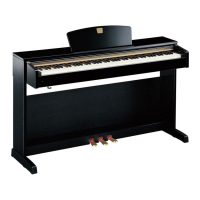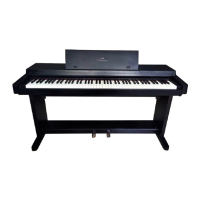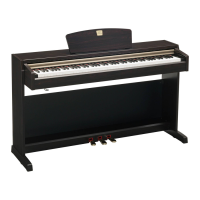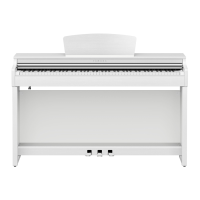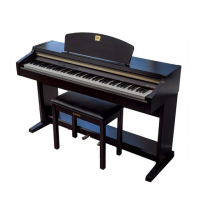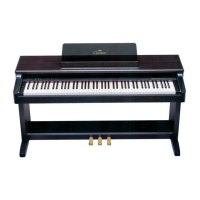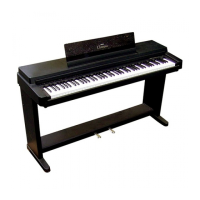
Do you have a question about the Yamaha Clavinova CLP-350 and is the answer not in the manual?
| Number of Keys | 88 |
|---|---|
| Sound Engine | AWM (Advanced Wave Memory) |
| Touch Sensitivity | Hard, Medium, Soft, Fixed |
| Effects | Reverb, Chorus |
| Connectivity | MIDI In/Out |
| Pedals | 3 (Damper, Sostenuto, Soft) |
| Speakers | 16cm x 2 |
| Finish | Rosewood, Black |
Ensure local AC mains voltage matches the voltage specified on the unit's name plate.
Covers safe operation, environment, and handling of the instrument.
Details power supply verification, servicing needs, and maintenance.
Explains potential interference from digital technology and FCC compliance.
Thanks for purchase, highlights AWM, touch response, and MIDI capabilities.
Advises thorough reading and safe keeping of the manual for optimal performance.
Open the box, remove all parts, and confirm all required components are present.
Connect side panels (D) and base boards (E) using joint connectors and gold screws.
Attach side panels to the pedal box and then attach the rear panel using screws.
Place and secure the main unit (A) onto the assembled stand using screws.
Connect pedal cords and ensure the adjuster is properly set for stability.
Guidelines for cleaning and maintaining the Clavinova's appearance and function.
Description of key controls like Power, Volume, Transposer/MIDI, Voice Buttons, Brilliance, and Reverb.
How to turn on the instrument, adjust volume, and select instrument voices.
Explanation of effects like Room, Hall, Cosmic, and the use of Sustain and Sostenuto pedals.
How to raise or lower the pitch in small increments for fine-tuning.
Procedure to return the instrument's tuning to the standard A4=440 Hz.
Explains MIDI as a digital interface for musical instruments and its benefits.
Illustrates how to connect MIDI devices using appropriate cables.
Overview of MIDI messages transmitted and received by the Clavinova.
Adjusts the overall pitch of the keyboard in half-step increments.
Allows fine adjustment of pitch in cents for precise tuning to other instruments.
Explains how to select MIDI transmit and receive channels for device communication.
Lists available MIDI functions and their corresponding voice button selections.
Details notes, dynamics, and controller messages sent and received by the Clavinova.
How to set MIDI transmit/receive channels and OMNI mode.
Managing local control and program change messages for MIDI communication.
Setting control change messages and activating the multi-timbre mode.
Using split keyboard function with local control disabled for MIDI output.
Sending Clavinova settings via MIDI for sequencer recording and playback.
Troubleshooting steps for no sound output, radio interference, or static.
Addressing distorted sound issues and other operational problems.
Listing available accessories and expansion modules to enhance Clavinova capabilities.
Detailed format for MIDI messages like Note On/Off, Control Change, and Program Change.
Technical specifications for the keyboard, voice selectors, and effects.
Details on jacks, input/output levels, amplifier power, speakers, dimensions, and weight.
Chart detailing transmitted and recognized MIDI messages for the Clavinova.
Overview of MIDI modes, system exclusive messages, and other message types.
Information regarding FCC regulations for Class B digital devices and modification notices.
Notices for Canada regarding radio noise emissions and for the UK on plug and cord connection.

